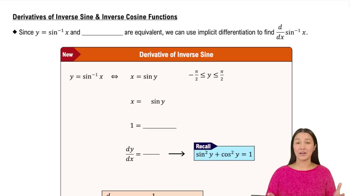Angle to a particle (part 2) The figure in Exercise 81 shows the particle traveling away from the sensor, which may have influenced your solution (we expect you used the inverse sine function). Suppose instead that the particle approaches the sensor (see figure). How would this change the solution? Explain the differences in the two answers. <IMAGE>
Table of contents
- 0. Functions7h 54m
- Introduction to Functions16m
- Piecewise Functions10m
- Properties of Functions9m
- Common Functions1h 8m
- Transformations5m
- Combining Functions27m
- Exponent rules32m
- Exponential Functions28m
- Logarithmic Functions24m
- Properties of Logarithms36m
- Exponential & Logarithmic Equations35m
- Introduction to Trigonometric Functions38m
- Graphs of Trigonometric Functions44m
- Trigonometric Identities47m
- Inverse Trigonometric Functions48m
- 1. Limits and Continuity2h 2m
- 2. Intro to Derivatives1h 33m
- 3. Techniques of Differentiation3h 18m
- 4. Applications of Derivatives2h 38m
- 5. Graphical Applications of Derivatives6h 2m
- 6. Derivatives of Inverse, Exponential, & Logarithmic Functions2h 37m
- 7. Antiderivatives & Indefinite Integrals1h 26m
- 8. Definite Integrals4h 44m
- 9. Graphical Applications of Integrals2h 27m
- 10. Physics Applications of Integrals 3h 16m
- 11. Integrals of Inverse, Exponential, & Logarithmic Functions2h 31m
- 12. Techniques of Integration7h 41m
- 13. Intro to Differential Equations2h 55m
- 14. Sequences & Series5h 36m
- 15. Power Series2h 19m
- 16. Parametric Equations & Polar Coordinates7h 58m
6. Derivatives of Inverse, Exponential, & Logarithmic Functions
Derivatives of Inverse Trigonometric Functions
Problem 3.R.29
Textbook Question
9–61. Evaluate and simplify y'.
y = tan^−1 √t²−1
 Verified step by step guidance
Verified step by step guidance1
First, identify the function y in terms of t. Here, y = tan^(-1)(√(t²−1)).
To find y', the derivative of y with respect to t, use the chain rule. The chain rule states that if a function y = f(g(t)), then y' = f'(g(t)) * g'(t).
Recognize that y = tan^(-1)(u) where u = √(t²−1). The derivative of tan^(-1)(u) with respect to u is 1/(1+u²).
Next, find the derivative of u = √(t²−1) with respect to t. Use the chain rule again: if u = (t²−1)^(1/2), then u' = (1/2)(t²−1)^(-1/2) * 2t = t/√(t²−1).
Combine the derivatives using the chain rule: y' = (1/(1+u²)) * (t/√(t²−1)). Substitute u = √(t²−1) back into the expression to simplify y'.
 Verified video answer for a similar problem:
Verified video answer for a similar problem:This video solution was recommended by our tutors as helpful for the problem above
Video duration:
5mPlay a video:
Was this helpful?
Key Concepts
Here are the essential concepts you must grasp in order to answer the question correctly.
Derivative of Inverse Functions
The derivative of an inverse function, such as the arctangent function, can be found using the formula: if y = tan^(-1)(u), then dy/dx = 1/(1 + u^2) * du/dx. This concept is essential for differentiating functions that involve inverse trigonometric functions.
Recommended video:

Derivatives of Inverse Sine & Inverse Cosine
Chain Rule
The chain rule is a fundamental technique in calculus used to differentiate composite functions. If a function y = f(g(t)), the derivative is given by dy/dt = f'(g(t)) * g'(t). This rule is crucial for evaluating the derivative of y = tan^(-1)(√(t² - 1)) since it involves a composition of functions.
Recommended video:

Intro to the Chain Rule
Simplifying Derivatives
After finding the derivative, simplifying the expression is often necessary to make it more manageable or interpretable. This may involve factoring, combining like terms, or rationalizing the denominator. Understanding how to simplify derivatives is key to presenting the final answer clearly.
Recommended video:

Simplifying Trig Expressions

 7:26m
7:26mWatch next
Master Derivatives of Inverse Sine & Inverse Cosine with a bite sized video explanation from Patrick
Start learningRelated Videos
Related Practice
Textbook Question
